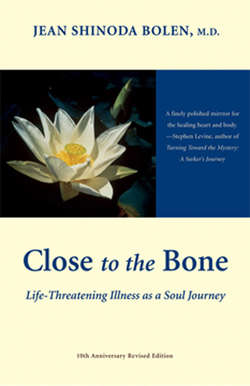Читать книгу Close to the Bone - Jean Shinoda Bolen - Страница 17
На сайте Литреса книга снята с продажи.
Close to the Bone
ОглавлениеThe first time I knew that illness was both a soul and body experience was when I was in my late twenties. I had just begun my psychiatric residency and took a six-month leave to be with my parents when my father came home to die. My father had lost a long, heroic struggle to overcome the cancer that had defeated his body, and even after medicine could offer no further even ameliorating procedures, his will to live kept him going for many more months. Yet as he died, I saw his eyes open wide, and his face light up with joy. I am convinced that he saw something I could not see, and I trust my perception and deeply appreciate the gift of seeing this. One moment, he was there, the next instant he was gone. Only an empty body remained; his soul had left. His body was warm, and some cells were probably still functioning seconds later, but he— his soul—wasn't there anymore. His suffering was over, and the body he left behind was like discarded clothes that were worn and threadbare, familiar and of no further use to the person who once wore them. His face told me that there was something beautiful to look forward to at death, and the period beforehand, in which he took a long time to die, left me with the belief that this period too was important. With an airway, talking was difficult, and in his last months, the inner world seemed to absorb him. Quite possibly, he died after staying as long as he needed to remain, to do whatever it was he had to do at the threshold between this world and the next. Dying people spend their days like newborns do, sleeping and dreaming and having their basic needs taken care of by others; the dreaming, the reverie, and the moments of clarity and conversation may not only ease the transition but be soul-healing time. In the intervening years since then, my son, my mother, and my closest friends have gone through medical or surgical crises. I found that when a child is going through major surgery, a mother feels the child's and her own vulnerability, perhaps more so than in any other relationship. It also was for a son on the edge of adulthood, an ordeal that had the elements of an initiation into manhood, and it clearly was a soul journey. The perspective I gave him may have made a difference in how he experienced what he went through.
When my eighty-five-year-old mother became too ill to go on, it seemed like the beginning of the end, which is what she and I thought until she made a full recovery and returned to her independent personal and professional life for three more years. I think that what I did and said tilted the scales and made a difference, though it was she—at a soul level—who made a decision to live, and her body was able to recover.
The medical and surgical crises that my closest friends have gone through affected me in a way that only contemporaries we love can; they bring home to us knowledge of how fleeting our own lives might be.
Everyone who comes to me for analysis or consultation brings me their close-to-the-bone concerns. Drawing on the depth and breadth of this experience convinces me that it is impossible in a lifetime not to be directly or indirectly affected by potentially disabling or potentially fatal illnesses: they can or will happen to us and to others around us. Whether we are the patient or a witness, when illness enters our circle of people, it touches us deeply. Life-threatening illness takes the patients, those who love them, and those who treat them into the realm of soul.
Such illnesses often take us by surprise. The shift between being healthy and being sick can happen to someone so precipitously that it leaves us stunned and without words for the depth into which we are plunged. Words from someone familiar with the territory may provide an orientation; images and metaphors that reflect what I know may be a starting point for inner reflection or the basis of a dialogue on a soul level with someone else. Whether suddenly or gradually, a life-threatening illness has the power to cut through illusions and bring us close to the bone, maybe for the first time in our lives.
To be brought “close to the bone” through the adversity of illness, the closeness of death, and the knowledge that we are not in control of the situation, is to come close to the essence of who we are, both as unique individuals and as human beings. Like X-ray films on which the bones are the most distinct because they are the strongest and most indestructible elements of the body, so it is that adversity reveals the eternal, and thus indestructible, qualities of the soul.
